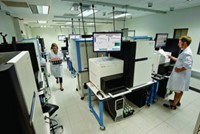Advertisement
Grab your lab coat. Let's get started
Welcome!
Welcome!
Create an account below to get 6 C&EN articles per month, receive newsletters and more - all free.
It seems this is your first time logging in online. Please enter the following information to continue.
As an ACS member you automatically get access to this site. All we need is few more details to create your reading experience.
Not you? Sign in with a different account.
Not you? Sign in with a different account.
ERROR 1
ERROR 1
ERROR 2
ERROR 2
ERROR 2
ERROR 2
ERROR 2
Password and Confirm password must match.
If you have an ACS member number, please enter it here so we can link this account to your membership. (optional)
ERROR 2
ACS values your privacy. By submitting your information, you are gaining access to C&EN and subscribing to our weekly newsletter. We use the information you provide to make your reading experience better, and we will never sell your data to third party members.
Genomics
Human Genome Map Turns 10
A decade after completion, many areas are reaping benefits, but new concerns have surfaced
by Britt E. Erickson
May 17, 2013
| A version of this story appeared in
Volume 91, Issue 20
The Human Genome Project officially ended in 2003. The $3.8 billion, 13-year effort accomplished its main objective of completing the sequence of the 3 billion chemical base pairs that make up human DNA.
The project has led to mandatory genetic information on the labels of more than 100 drugs, has fostered new ways of treating cancer, and has rewritten anthropology texts with a view of early human migration that’s different from that shown by stones and bones. It also laid the foundation for sharing data freely without restrictions and catalyzed a multi-billion-dollar biotechnology industry in the U.S.
To download a PDF of this story, go to http://cenm.ag/hgp.
But it’s still too soon to tell whether the project will live up to its promise to truly revolutionize medical care. A lot of work still needs to be done to bring the full power of genomics to the clinic.
To assess the impact of the Human Genome Project a decade after its completion, scientists gathered at a symposium at the National Institutes of Health last month. The date of the symposium, April 25, also marked the 60th anniversary of the discovery of the double-helical structure of DNA.
At its start, the genome-mapping effort was hugely controversial. “The majority of the scientific community was either skeptical or frankly opposed to this project,” recalled NIH Director Francis S. Collins, who led NIH’s National Human Genome Research Institute (NHGRI) from 1993 to 2008. People were concerned that it was technically unfeasible, might take away money from their basic research grants, or was just so boring that no good scientist would want to work on it, he said.
Collins pointed out that NIH is facing similar opposition today with respect to the recently announced Brain Research through Advancing Innovative Neurotechnologies (BRAIN) Initiative (C&EN, April 8, page 9). That effort aims to develop new ways to map brain circuitry so researchers can unravel how brain function is linked to behavior, learning, and disease.
Collins played a game with the symposium audience, asking them to guess whether various quotes were said in 1988 about the then-just-announced Human Genome Project or this year about the BRAIN Initiative. The quiz was published on April 5, 2013, in Wired magazine.
The audience got off to a good start with this quote: “The project is bad science, it’s unthought-out science, it’s hyped science.” They correctly guessed the genome project.
But they struggled with this one: “Concentrating hundreds of millions of dollars on this one megaproject in the era of budget cuts is sure to starve hundreds of small, more promising biomedical research projects.” The correct answer is the genome project, which most people did not guess.
THE HUMAN GENOME PROJECT THROUGH THE YEARS
Despite the early concerns, the Human Genome Project was successful, Collins said, finishing two years ahead of schedule and $400 million under budget. “One of the reasons the genome project succeeded was because it was so compelling. It was so game changing. It was so interdisciplinary,” he emphasized.
Others who have also worked in genomics since the beginning of the Human Genome Project say the future of the field looks bright. If DNA sequencing costs continue to plummet, within a few years sequencing individual genomes will be affordable for routine medical care. Current costs are $4,000 to $6,000 per genome, compared with about $10 million to $50 million when the project ended in 2003 and $1 billion when it started in 1990, according to NHGRI Director Eric D. Green.
At last month’s symposium, Green reminisced about the early days of the genome project when DNA sequence information was generated using radioactive labels and shared via fax. Today multiple technologies are available for DNA sequencing, results are shared by e-mail and Twitter, and an entire genome sequence can be stored on a thumb drive.
Green noted several medical advances that resulted because of the genome project. For example, today there are 4,847 rare genetic diseases with a known molecular basis. There were 2,264 in 2003 and just 61 in 1990, Green said. Similarly, the number of genes with known disease-causing mutations has more than doubled from 1,474 in 2003 to 2,973 today. The number was 53 in 1990.

The number of single-nucleotide polymorphisms (SNPs) in public databases has also increased dramatically as a result of the Human Genome Project. Today there are about 54 million, compared with 3.4 million in 2003 and 4,400 in 1990, Green noted.
SNPs are variations that occur when a single nucleotide—A, T, C, or G—in the genome differs among individuals. Multiple SNPs in people with and without a particular disease can be examined in genomewide association studies to determine whether any SNPs are associated with the disease. About 1,550 of these studies have been published since the completion of the Human Genome Project, according to Green.
Collins believes such studies may be useful for identifying new drug targets. “The major advantage here is to understand disease pathogenesis and pathways and to utilize that information to come up with new ideas about therapeutics. We have not taken advantage of that as we might have, and it is time,” he said.
One disease where advances in genomics have already changed how patients are treated is cancer. Doctors are linking particular genomic profiles with outcomes and deciding which drugs to give patients on the basis of genomic information.

Currently about 11,000 tumors are being sequenced to identify subsets of cancer and target therapy more effectively. Through an effort called the Cancer Genome Atlas, the goal is to have the sequences completed by the end of 2014. “Cancer patients will clearly be one of the big early winners due to genomic applications to medicine,” Green said.
The single largest application of genetic testing to date is newborn screening, said Jeffrey R. Botkin, a professor of pediatrics at the University of Utah. In 2003, 46 states tested for six conditions in newborns using a dried blood spot from a heel stick. Today, all states test for more than 30 conditions from a dried blood spot, Botkin noted. The change was driven by technology more than philosophical reasons, he said. The Human Genome Project spurred that technology development.
Despite advances in technology, genomics has yet to live up to its full potential for routine clinical care. One of the reasons is that it isn’t yet feasible to sequence the entire genome of every newborn in the U.S. to predict a baby’s risk of developing various conditions. Although the amount of time it takes to sequence a human genome has fallen dramatically from six to eight years in 1990 to two to three days today, states do not yet have the infrastructure to conduct such large-scale testing or to manage the counseling that is necessary when results are disclosed.
Cost is also a concern. Assuming the cost of sequencing drops as low as $1,000 per human genome, with 4 million babies born each year in the U.S., that amounts to $4 billion per year for sequencing.
Sequencing every newborn child also raises questions about the ethical, legal, and social implications (ELSI) of the results. Since the beginning of the genome project, NHGRI has invested about 5% of its budget on ELSI studies. In total it has spent about $300 million toward about 470 ELSI grants.
Work in this area focused congressional attention on the potential for insurance companies and employers to discriminate against people on the basis of their genetic profile. In 2008, Congress passed the Genetic Information Nondiscrimination Act to address the issue. Other areas, such as privacy, access to genomic data, and direct-to-consumer marketing of genetic information, have also been debated on Capitol Hill. NIH is interested in how people would use genomic information if they received it from their doctors.
“We can say today that genomics is beginning to have meaningful impact on medicine,” Green said, pointing out that the Food & Drug Administration requires genetic information on the labels of 106 drugs on the market. The labels alert doctors that certain genomic information should be considered when prescribing a particular drug. Before the genome project, only four drugs had such labels, Green noted.
Over the past decade, genomics has begun to play an important role in numerous areas. But Collins gets annoyed when people say, “We are in the postgenomic era.” That won’t happen, he said, “until we actually figure out how the genome functions.”





Join the conversation
Contact the reporter
Submit a Letter to the Editor for publication
Engage with us on Twitter